Keep refreshing to stay up to date
4.05pm That’s all folks
Thanks for joining us today. We hope you’ve enjoyed the coverage today as much as we’ve enjoyed bringing it to you. If you’re still thirsty for more Nobel prize-winning science then we’ll be back with a feature length article next week so keep an eye out for that one.
3.52pm Still confused about cryo-EM?
What is cryo-EM? What can it do? What contribution did today’s laureates make? We’ve got all the answers to your questions covered.
3.20pm Quick reminder
You can find all our Nobel prize coverage in one handy place.
3.07pm Read all about it!
‘I was overwhelmed. I thought the chances of the Nobel prize were miniscule.’ Who said that? You can read all about it in our news story.
2.19pm Predictions redux
Having been back over all the predictions we saw and covered this year we didn’t find anyone who had cryo-EM down as a possible. There’s certainly been a buzz around it as can be seen in our recent feature article and Derek Lowe’s recent blog but the feeling seems to have been that the technique hadn’t proved itself sufficiently to take a Nobel. Having said no one predicted this award, this is just among the predictions we saw this year. But it turns out that a blogger last year had both Richard Henderson and Joachim Frank on their list. So bragging rights go to artkqtarks.
2.02pm Joachim Frank’s first retweet since the announcement!
Joachim Frank on receiving the phone call from Stockholm today. Interview coming soon! pic.twitter.com/dXcIErqX2X
— The Nobel Prize (@NobelPrize) October 4, 2017
1.59pm Where are they now?
So what are Jacques Dubochet, Joachim Frank and Richard Henderson up to now? Well Dubochet retired back in 2007 and is now an honorary professor of biophysics at the University of Lausanne in Switzerland. Dubochet won the Lennart Philipson Award for outstanding contributions in translational research and interestingly enough credits his fear of the dark as a child as sparking his interest in science. The Lennart award announcement is worth a read.
Joachim Frank is still an active researcher at Columbia University in the US. He’s received a number of awards including the Benjamin Franklin Medal in Life Sciences from the Franklin Institute in the US in 2014 for the development of cryo-EM. He’s also a budding fiction writer and you can see his work over at Franx Fiction. He’s had a number of short stories and poems published and you can read many of them over on his website. You might also be interested to know that his son is Ze Frank, the comedian and composer.
Richard Henderson is still active and working at the MRC Laboratory of Molecular Biology (LMB) in Cambridge. He was the first person to use x-ray crystallography to solve the structure of a membrane protein, bacteriorhodopsin. Cryo-EM then gave Henderson the opportunity to investigate this protein and others at the atomic level without having to make crystals. He has been honoured a number of times and received the Royal Society’s Copley Medal last year and the Gregori Aminoff Prize in 1999. He was also director of the LMB division of structural studies for 10 years – researchers at the LMB have won 11 Nobel prizes over the years.
1.24pm The Twitterati weigh in
Excited! As a structural biophysicist & that I am teaching cryo-EM for next few weeks in class @Vassar! #chemnobel https://t.co/gpPwGkezhR
— Krystle McLaughlin (@biophyskrys) October 4, 2017
In many ways, today's #chemnobel is a testament to string-and-sealing-wax science: detectors, electronics, code, low-temp technology.
— Ashutosh Jogalekar (@curiouswavefn) October 4, 2017
This morning, thousands are learning that their phones autocorrect "cryo" to "crying" ... @NobelPrize #chemNobel
— Matthew Hall (@cispt2) October 4, 2017
Still not #Goodenough #chemnobel
— BD_Alexander (@bd_alexander) October 4, 2017
Cryo-EM very promising, but funny how it's already mature enough for a Nobel Prize while lithium-ion batteries aren't. #chemnobel
— Ashutosh Jogalekar (@curiouswavefn) October 4, 2017
I have made it from postdoc to full professor without a single female chemistry laureate...(last was Ada Yonath 2009) #STEMwomen #chemnobel
— Lynn Kamerlin (@kamerlinlab) October 4, 2017
#chemnobel Twitter bingo. #RealTimeChem pic.twitter.com/FxDxdT4F3u
— Susan Vickers (@susanmvickers) October 4, 2017
Obligatory it’s nice but it’s not chemistry tweet!
This could easily be a Physics Nobel, its either 2 Physics or 2 Biology. No Chemistry this time as well. #chemnobel
— Dr. Muneer Ahamed (@ahdchem) October 4, 2017
12.17pm Reactions to Cryo-EM taking the prize
Anne Glover, President Elect of the Royal Society of Edinburgh, said:
’When I was doing my PhD, I remember visiting Richard at the MRC labs the day it was announced that Fred Sanger had won his second Nobel. Richard gave me great help with my PhD and ended up one of the examiners of my thesis. He was always happy to talk about ideas and to help so it is great that he has been awarded the Nobel for Chemistry.’
Colin Blakemore, Emeritus Professor of Neuroscience at the University of Oxford, said:
’This is wonderful news – for the UK, for the MRC, for the glorious MRC Laboratory of Molecular Biology in Cambridge – and for Richard, of course. This is the 11th Nobel Prize for one institute!
Richard was the Director of the LMB for several years, during the complex planning of the new building. Despite the demands of that job, he continued his own remarkable science. He works on G-protein-coupled receptors (GPCRs). These are protein molecules in the membranes of cells that are stimulated by hormones, transmitters etc, and which work by activated so-called G-proteins that are linked to the receptor. In turn the G protein can turn on a variety of intracellular signalling pathways, to control the activity of the cell. GPCRs are very important in neurons. They are prime targets for drugs because of their involvement in a wide variety of diseases. But drug development depends on understanding the precise structure of the GPCR molecule. This proved to be extremely difficult and Richard had to develop new methods for doing this.’
Hugh Pelham, Director of the MRC Laboratory of Molecular Biology, said:
’My warmest congratulations to Richard Henderson as well as Jacques Dubochet and Joachim Frank. This is a fantastic recognition of very many years of work developing this technology, which is already helping to solve key problems related to human health. It is incredible what can now be done. The impact will be profound and I am proud that the MRC Laboratory of Molecular Biology has played such a central role in this.’
Dame Carol Robinson, Professor of Chemistry at the Physical and Theoretical Chemistry Laboratory, Oxford University, said:
’I am delighted to see this research recognised in this way. It is truly transformative allowing us to see new images of biomolecules - I am personally very happy for Richard who predicted this would be possible many years previously.’
Jim Smith, Director of Science at Wellcome, said:
‘Warmest congratulations to Dubochet, Frank and Henderson for their Nobel Prize in Chemistry. Cryo Electron Microscopy is at the forefront of structural biology research, having undergone something of a resolution revolution in recent years. This prize recognises the contribution that the teams who developed cryo-EM have already made to research, and that it will continue to advance the field for many years to come. By solving more and more structures at the atomic level we can answer biological questions, such as how drugs get into cells, that were simply unanswerable a few years ago. Equipping UK researchers with the technology to undertake world-leading science is absolutely paramount, and Wellcome’s recent awards in this area will have far-reaching benefits across the life sciences.’
Daniela Rhodes, NTU Institute of Structural Biology, Singapore, said:
’This is great news! Electron Microscopy is revolutionising structural biology and these three fully deserve the prize. Their contributions has opened up the field to researchers all over the world to determine the structure of huge machines in cells as well as smaller protein structures that will reveal how biology and medicine work. This is a well-deserved Nobel Prize!’
11.52am Laureates taking it easy
After winning a Nobel prize things tend to go a bit crazy for a few months – or so we’ve been told. Stopping for a second seems impossible thanks to the constant media requests and invitations to speak. We spoke to seven Nobel laureates and asked them how they relaxed when they found some spare time.
11.43am Currently enjoying…
Jacques Dubochet’s CV. Featuring such gems as: 1946 No longer scared of the dark, because the sun comes back; it was Copernicus who explained this.
11.25am Amazing images
Just like the 2014 Nobel prize this technique has delivered a raft of great images inside the cell. Here, scientists at Purdue University, US, have used cryo-electron microscopy to study the Zika virus.
V M Prasad et al, Nature Structural & Molecular Biology, 2017, 24, 184 (DOI: 10.1038/nsmb.3352)
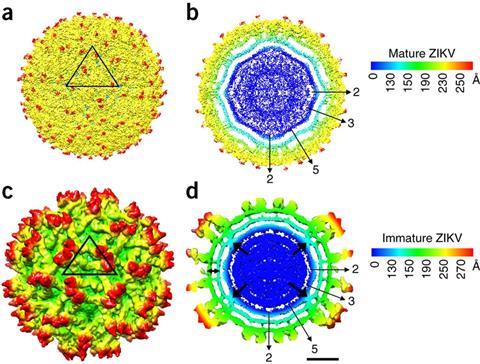
11.13am More on Cryo-EM
We have an older feature on the technique which includes a nice description of how cryo-EM works.
CryoTEM explained
Transmission electron microscopes (TEM) use electrons instead of light. A source at the top of the microscope emits electrons that travel through vacuum. Electromagnetic lenses focus the electrons into a very thin beam, which then travels through the sample. Electrons left unscattered by the sample hit a fluorescent screen to give a shadow image.
In cryogenic-temperature transmission electron microscopy (cryoTEM), thin films of the sample liquid are cooled at ultra-fast rates before being transferred to the transmission electron microscope and maintained at cryogenic temperature. A small drop of the sample is applied to a TEM grid held inside a controlled environment vitrification system (CEVS). Blotting with filter paper gives thin liquid films that span the holes in the grid.
The films should be no thicker than about 300nm and of very low vapour pressure to make them compatible with the high vacuum conditions and the limited penetration power of the electron beam.The temperature and atmospheric composition in the CEVS are controlled to minimise volatile loss and to allow quenching of the liquid.
The grid is then plunged into a cryogen such as liquid ethane at -170C. This vitrifies the sample with a cooling rate of about 10,000C per second. It is then stored under liquid nitrogen and transferred to a TEM cooling holder. The sample must be kept at cryogenic temperatures to avoid phase change and sublimation of volatiles.
11.00am Something of a surprise
We think this is somewhat unexpected. Cryo-electron microscopy wasn’t on many (any?) people’s lists of predictions that we can recall but we’ll be going over those lists shortly to see if anyone has got bragging rights. Cryo-electron microscopy is a technique that enables the 3D visualisation of biomolecules at high resolution – check out our feature for an overview of this powerful technique. One of Chemistry World’s columnists Derek Lowe recently wrote an interesting take on cryo-EM. Coming so soon after another chemistry Nobel for a microscopy technique – the 2014 prize – it’s a bit of a surprise. Stay tuned for our news story later today.
10.51am So there it is
BREAKING NEWS The 2017 #NobelPrize in Chemistry is awarded to Jacques Dubochet, Joachim Frank & Richard Henderson. pic.twitter.com/RUZSnArJHO
— The Nobel Prize (@NobelPrize) October 4, 2017
10.48am And the prize goes to…
The chemistry Nobel prize goes to Jacques Dubochet, Joachim Frank & Richard Henderson for cryo electron microscopy. Congratulations!
10.47am Here we go
…
10.41am On time
I believe I heard someone telling the press pack that everything was running on time so we can expect the announcement in four minutes…
10.36am Visualising the Nobel prize
Over at the RPubs website some interesting analysis has been performed on data from the Nobel Foundation website. There’s graphics on gender, age distribution and country of birth and death of Nobel winners (the trend of the best scientists migrating to the US is stark). Well worth a look.
10.31am Oooh there’s movement in Sweden
10.31am Women winners wanted
Science blogger Alice Grey wrote a piece for us on how to improve the gender balance in science’s most prestigious award
10.24am Sweepstakes
A betting pool in the Perez lab at IMDEA-Nanociencia. Not sure the person with total synthesis is onto a winner there!
Here's our pool for #chemnobel 2017 @IMDEA_Nano crispr, perovskites, Li-ion batteries...and some others, too! 30 min left! pic.twitter.com/O1qRrGDJSH
— Emilio M. Pérez (@emiliomperezlab) October 4, 2017
10.19am Gender and the Nobel prize
A majority of Nobel prize winners believe that bias plays a part in explaining why so few women win one. That’s the result of a recent poll of almost 50 laureates.
And following that bit of news here’s some relevant stats on the chemistry Nobel prize. 108 prizes have been presented to 175 Nobel laureates since the prize started in 1901. Of those 108 prizes only four have gone to women (Marie Curie 1911, Irène Joliot-Curie (Marie Curie’s daughter) 1935, Dorothy Crowfoot Hodgkin 1964 and Ada Yonath 2009). (In case you were wondering the average age of a chemistry Nobel laureate when they receive the prize is 58.)
10.11am Join the conversation
If you’re not following us on Twitter, now is a good time. We’ll keep you up to date with thoughts about the Nobel prizes from across the twittersphere at @ChemistryWorld
10.09am Perks of the prize
The old joke among academics has it that the best thing about winning a Nobel prize is that you get your own parking space. In the bicycle-mad Netherlands they have their own take on this…
Thank you @NobelPrize, for sharing our video of our Nobel Laureate Ben #Feringa's new parking place! https://t.co/Hd77bNY1EH pic.twitter.com/9Cttc8sZ5w
— University Groningen (@univgroningen) August 25, 2017
10.05am How can I win a Nobel prize?
Want to know what it takes to win a Nobel prize? Or how the judging panel makes its decision? We talked to Bengt Norden, who served on the chemistry Nobel prize panel for a decade, about the controversies, calamities and claims that never quite made it.
10.03am All your Nobels belong to us
By the way, all our stories and videos on the Nobel prizes can be found in one handy place.
10.02am More on winning that top prize
What is it like to win a Nobel prize? Jeffrey C Hall, who shared Monday’s physiology or medicine Nobel prize with Michael Rosbash and Michael W Young for their work on animals’ internal clocks, says receiving a call from Sweden was unexpected. He’s now wondering what to do with the prize money as he’s not doing research any more – he retired 10 years ago! A holiday perhaps?
9.57am Yet more predictions
The good people over at Chemical & Engineering News hosted their annual webcast featuring some crystal ball gazing from top figures in the chemistry community last week. In the hour long chat they make a number of predictions including who’s in with a chance this year, fundamental research without an application that could win and who looks increasingly likely to have been snubbed by the Nobel committee (regular Nobel watchers won’t be surprised to hear that John Goodenough of lithium-ion battery fame is in that last category).
9.55am What’s it like to get the call from Sweden?
Ever wonder what it might feel like to win a Nobel prize? Chair of Chemistry World’s editorial board (just saying again! ;-) and, of course, 2016 chemistry Nobel laureate Ben Feringa wrote for us last year on how he found out and how it felt to be told he had won a Nobel prize.
9.50am Simpsons did it!
The Simpsons has a pretty good track record when it comes to predicting the chemistry Nobel prize so far having got Ben Feringa (2016) and WE Moerner (2014) correct. Can they make it three out of four…?
Fun fact via @MIT: The Simpsons once predicted Ben Ferringa would win a Nobel Prize. Six years later, it came true! https://t.co/Y36V4LH8mH pic.twitter.com/3fJS1GQjvs
— Uni. Groningen FEB (@UniGroningenFEB) December 7, 2016
9.46am There can be only three
Lots of talk this year over the Nobel prize honouring just a few individuals (the original bequest from Alfred Nobel says that the prize can be shared among a maximum of three recipients) when, more often than not, science is a team effort. Physics in particular is a field where huge teams and enormous infrastructure projects have been behind some of the discoveries that have won the Nobel prize recent years such as gravitational waves and the Higgs boson. The perennial question: is it time the Nobel Foundation changed its rules to honour team efforts?
We hail individual geniuses, but success in science comes through collaboration | Jeremy Farrar https://t.co/NJ6KEYc0SP
— Guardian Science (@guardianscience) September 30, 2017
Prof Martin Rees tells @bbcnews: "@LIGO's success was owed to hundreds of researchers. The fact that the #NobelPrize2017 committee refuses to make
— Pallab Ghosh (@BBCPallab) October 3, 2017
group awards is causing increasingly frequent problems + giving a
misleading impression of how a lot of science is actually done".
9.38am The widsom of crowds?
A poll over at Chemistry Views has been taking the pulse of the chemistry community. They’ve polled almost 500 people online, and they expect the winner to be a man, a biochemist and work in the Americas. Among the individuals that received more than five votes were Michael Grätzel (dye sensitised solar cells), Krzysztof Matyjaszewski (radical polymerisation) and K C Nicolaou (presumably a lifetime award for organic chemistry) – and I note that none of the people that received more than five votes is a biochemist!
9.33am Nobel laureates’ favourite molecules
Want to hear more from Barry Sharpless? We talked to seven Nobel laureates at a conference at Chalmers University in Sweden and they told us about their favourite molecule, and we learnt a few things we weren’t expecting…
9.27am Double jeopardy
Only one person, Fred Sanger, has won the chemistry Nobel twice. Could Barry Sharpless share his crown? Sharpless already won a share of the 2001 chemistry Nobel prize for his work on chirally catalysed oxidation reactions.
9.17am Laughing and thinking
Just as there is day and night, yin and yang and cis and trans there are also the IgNobels. The irreverent counterparts to the Nobels recently had its award ceremony and answered many questions that no one has ever asked, such as are cats solid or liquid, can digeridoos treat snoring and why is cheese disgusting? The research that first makes you laugh and then makes you think is always worth a read.
9.07am More predictions
Ash Jogalekar over at the Curious Wavefunction blog has refined his Nobel predictions (he notes it gets easier to do every year!) and he’s got a number of names that will be familiar to chemistry Nobel watchers. Harry Gray is there with Steve Lippard for contributions to bioinorganic chemistry. John Goodenough for lithium–ion batteries alongside Stanley Whittington. And he puts Barry Sharpless for click chemistry together with Marvin Caruthers for DNA synthesis under the auspices of organic chemistry. He’s decided to put Crispr-Cas9 in the medicine Nobel category though – a number of people have tipped Crispr for the chemistry prize or put it in the definitely going to get the prize, but just not quite yet category.
8.55am Twitter is for everyone
Since Sir Fraser won his Nobel he has taken to Twitter and he has apparently been trying to get his fellow 2016 laureates Ben Feringa (also on our editorial board – just saying again!) and Jean-Pierre Sauvage to start tweeting. No luck so far though!
8.51am Here be monsters…
Winning a Nobel prize can change you into a monster apparently… but of a nice sort!
"I am now labelled as a Twitter monster!" @sirfrasersays discusses 1ST yr as Nobel Laureate & why he loves to tweet: https://t.co/qVcwIuKaf3 pic.twitter.com/9HsNKeDprU
— The Nobel Prize (@NobelPrize) September 27, 2017
8.45am From one top chemist to another
One of last year’s chemistry Nobel laureates, Fraser Stoddart, (also on our editorial board – just saying) recently received a nice tribute from Berkeley University’s Omar Yaghi. Yaghi himself has been tipped to be a winner for his work on metal-organic frameworks and is no stranger to the pages of Chemistry World. Our correspondent Katrina Krämer recently spoke with MOF pioneer Yaghi about his work and it’s well worth a listen (or read if you prefer).
Popular this week: The Invisible Bond – A tribute to Sir Fraser Stoddart by Omar Yaghi https://t.co/EycSzXSiEF pic.twitter.com/LykTo5BpQp
— ChemistryViews (@ChemistryViews) August 18, 2017
8.36am More predictions
Have you voted in the @NatureChemistry poll? Looks like chemtweeps are putting their money on lithium–ion batteries. There’s still time to vote!
OK chemtweeps, it’s #ChemNobel Eve, so time for a poll. What topic do you think will (not should) win tomorrow?
— Nature Chemistry (@NatureChemistry) October 3, 2017
8.33am Predictions and more predictions
Who and what will be taking chemistry’s top gong this year? John Goodenough and lithium–ion batteries? Henry Snaith and perovskite solar cells? Harry Gray and bioinorganic chemistry? Only a select few know but that hasn’t stopped people making the usual measured, sensible predictions – and some more off the wall suggestions. You can check out our article on the predictions that people have been making here. And if you have your own predictions then let us know BTL.
8.32am Keep in touch!
All the Chemistry World team will be on Twitter this morning keeping up with what’s going on so say hi if you see us. If you want to get something onto the live blog then tweet us @ChemistryWorld or leave us a comment below the line.
8.23am A picture is worth a thousand words!
For a roundup in infographic form of the research that won last year’s Nobel prizes check out this from the Compound Interest blogger Andy Brunning. Nice, simple and easy to digest explanations. You can tell he’s a chemistry teacher!
Ready for the #NobelPrize announcements this week? Here's what won last year's three science prizes: https://t.co/3HOSruTWvW pic.twitter.com/MUqjCorh98
— Compound Interest (@compoundchem) October 1, 2017
8.20am What happened last year?
If you want a quick refresher on who won last year’s chemistry Nobel then check out our Supraheroes feature on molecular machines.
8.15am Staying connected
The press conference is expected to start at around 10.45am UK time (11.45am CET), barring any problems contacting the new Nobel laureates. We’ll be hosting the chemistry Nobel live feed here once they get going and you can head over to the Nobel Foundation’s website to catch up with all things Nobel too. We’ll be tweeting from @ChemistryWorld all things Nobel prize related and recommend the #chemnobel hashtag to keep up with what people are saying.
8.11am Let’s get cracking!
Morning everyone, and thanks for joining us. Excitement is building as we get closer to the announcement of the chemistry Nobel prize. Quick recap: we’ve already had two of the three Nobel science prizes – Monday was the medicine or physiology prize with work on animals’ internal clocks winning and yesterday was physics’ turn with the detection of gravitational waves taking the gong, as many pundits had predicted. Chemistry is often a trickier field to make predictions that stick, however… But stick with us this morning as the Chemistry World team will be live blogging the run up to the chemistry Nobel prize and of course after the announcement is made.
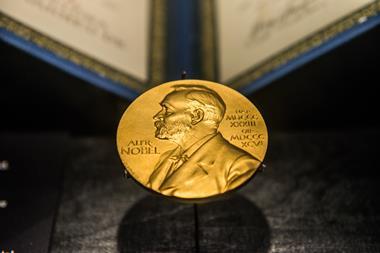
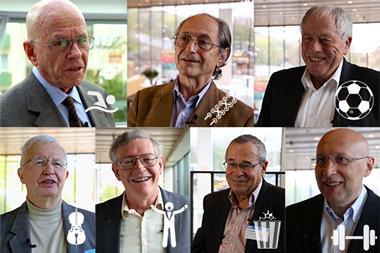
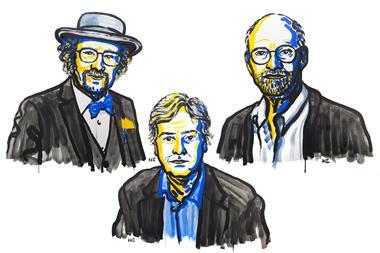

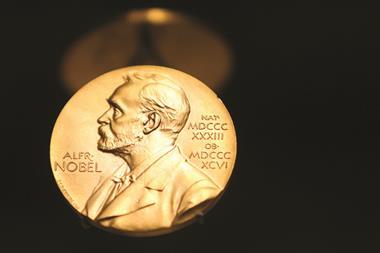







No comments yet